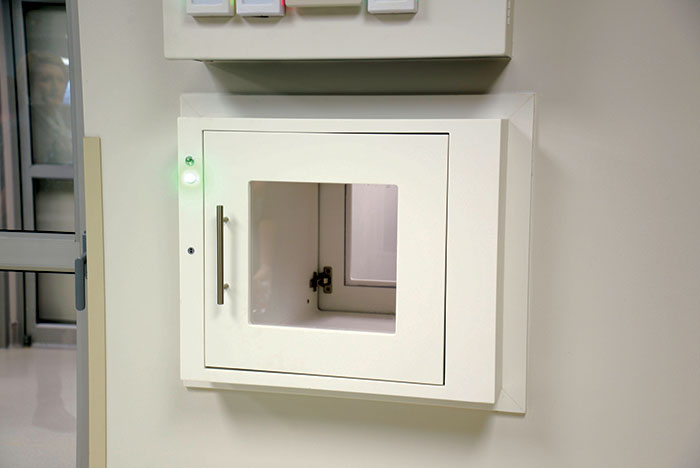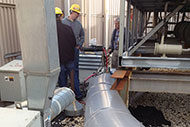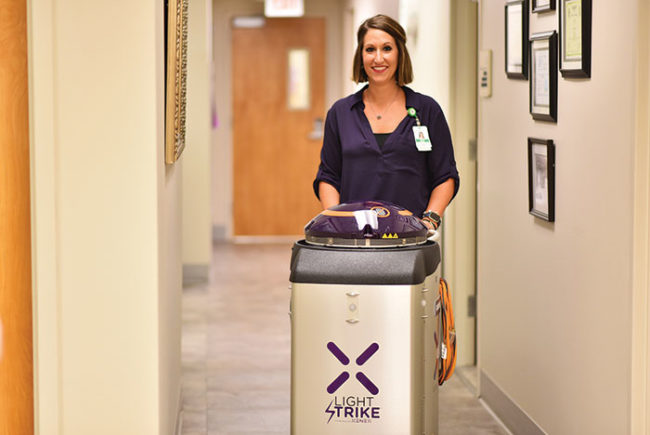
Clean room pass-throughs helped The University of Kansas Health System achieve USP 797 and USP 800 pharmacy compliance.
The University of Kansas Health System (TUKHS), Kansas City, Kan., partnered with an architectural firm to bring several pharmacies in its system into compliance with new regulations Kansas and several other states recently have adopted.
The regulations — the United States Pharmacopeia's USP 797 and USP 800 — include workroom air pressure requirements, specialized workflows, isolation measures and sterility conditions related to compounding, which is the preparation of prescription drugs for patients.
One aspect of the health system’s pharmacies that needed updating to comply with the new rules was the clean room pass-through, which is commonly used in pharmacies for drug preparation. Clean rooms are pressurized and sterile to ensure that drugs are safe.
Pass-throughs are two-sided cabinets built into a wall to connect the pharmacy and clean room for the transfer of supplies and drugs without jeopardizing sterility. Only one door of the pass-through can open at a time, which keeps the pressurized system intact, preventing any contaminants from entering the clean room.
Through a partnership between Shield Casework, North Kansas City, Mo., and the hospital, the company developed a new pass-through for TUKHS that met both compliance and budgetary requirements.
“Because we were redoing our pharmacy, we wanted to make it better and safer for patients who receive the drugs,” says Nick Burke, capital project manager, TUKHS.
Basil Sherman, principal, Pulse Design Group, Lexena, Kan., says pass-throughs they considered for installation did not include alert features that inform staff when an item in the pass-through can be removed, which can improve workflow.
Sherman reached out to Shield Casework and, through a collaborative process with the design team as well as the hospital’s stakeholders, the company developed a new pass-through that met all the health system’s needs.
One of the major benefits of the new pass-through is that it is constructed from solid surface — a nonporous, bacteria- and stain-resistant and durable material whose distinctive elements are well-suited to sterile environments.
Solid surface can be fully seamless for ease of cleaning and is less expensive than commonly used stainless steel. Moreover, the material’s flexibility more easily integrates electrical fixtures than stainless steel.
Shield’s pass-through features an electronic magnet system to lock the pass-through door when its opposite side is in use. This keeps the environment sterile without curtailing pharmacy staff efficiency.
The pass-through includes an indicator light that glows red if the opposite side door is open, which allows staff to see from 20 feet away whether the pass-through is in use on the opposite side. Additionally, the company worked with the design team to add a second indicator light that glows green to alert staff when an item is in the pass-through and ready to be removed.
"These new pass-throughs have indicator lights that improve staff communication and trouble-shooting, which improves our workflow. Also, because they are fully seamless, they don't support microbial growth, making the environment cleaner," Burke says.
"Everything about this pass-through design was planned with the goal of improving workflow,” says Stephen Hopkins, president and product designer, Shield Casework. “We tested every detail for use, feel and function.”
The pass-through’s generally unseen role in patient safety is invaluable and unknown to most except for the many clinical staff involved with the pharmacy department and distribution of medication, Sherman says.
“Pass-throughs are a critical part of the hospital,” Burke agrees. “We’re happy to now have ones at TUKHS that we know will keep our patients as safe as possible, while providing the best operational system for our team.”
Jeff Ferenc is senior editor of Health Facilities Management.




